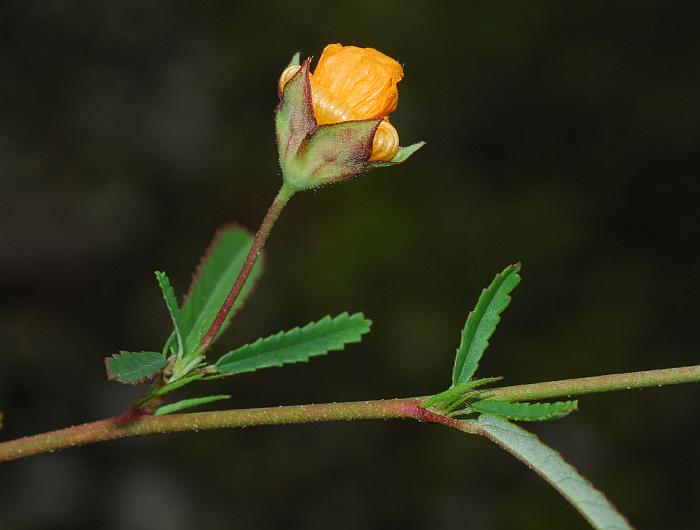Sida elliottii Torr. & A. Gray
Elliott's Sida

Native
CC = 10
CW = 5
MOC = 6
SRank = S1
© SRTurner
Sida elliottii Torr. & A. GrayElliott's Sida | |
 |
Native CC = 10 CW = 5 MOC = 6 SRank = S1 |
© SRTurner |
|
Family - Malvaceae Habit - Perennial forb. Stem - Spreading, ascending, or erect, usually branched, to 1 m, pubescent with minute stellate hairs.
Leaves - Alternate, on petioles shorter than axillary flower stalk. Stipules present, persistent, linear. Blades simple, narrowly elliptic or oblong, bluntly pointed, regularly toothed, upper surface usually glabrous, lower surface with stellate hairs.
Inflorescence - Flowers solitary in leaf axils, also in small terminal clusters. Bractlets absent.
Flowers - Calyces 5-7 mm long, partially fused, the triangular lobes tapered to a sharply pointed tip, pubescent with minute stellate hairs, the margins and keels with longer simple or fasciculate hairs. Petals 10-16 mm long, asymmetric at tips, orange. Stamens numerous. Pistils usually with 10 locules and style branches, arranged in a ring.
Fruits - Schizocarps breaking into 8-12 (usually 10) mericarps. Mericarps 3-5 mm long, wedge-shaped, brown to dark brown, with a pair of short erect beaks toward the tip, oblong to kidney-shaped in profile, minutely pubescent with stellate and fasciculate simple hairs toward the tips.
Flowering - August - October. Habitat - Sand prairies and glades, roadsides. Origin - Native to the U.S. Lookalikes - None. Other info. - This is Missouri's native sida, and a far more showy and attractive plant than the introduced species! Unfortunately, it is uncommon in the state, being found so far in only six counties, mostly at the extreme southeastern section of the state. Relative to the far more common Sida spinosa, it is larger and more branched, and its flowers larger and more orange in color. There are reports that the flowers open at sunset, but this behavior is not consistent across all individuals. The leaves and fruits are also interesting and attractive. This plant is deserving of much wider cultivataion. Photographs taken at Sand Prairie Conservation Area, Scott County, MO, 10-4-2017; also from first-generation plants grown at Shaw Nature Reserve from seeds taken from the Sand Prairie CA plants, 8-30-2018 (SRTurner). |